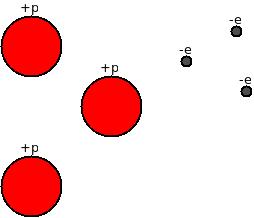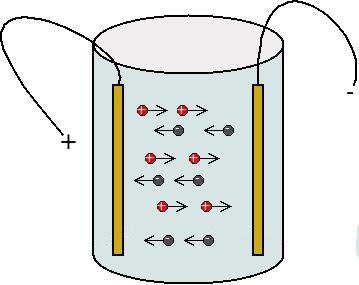Watching a number of YouTube videos, I realized there is some misconception regarding the electric current and how it flows. Some people don’t understand what the current is made of and whether it flows from positive to negative or vice versa.
So here I am, trying to shedding some light to clear the obscurity on this subject.
This post approaches the subject in a very basic qualitative way. No formulas and no calculations are involved.
Here it is!
From the Webster Dictionary
Current:
A flowing or passing; onward motion. Hence: A body of
fluid moving continuously in a certain direction; a
stream; esp., the swiftest part of it; as, a current of
water or of air; that which resembles a stream in motion;
as, a current of electricity.
So, current is the flow of something, some kind of material thing like the molecules of water in a river.

But, what is the material that makes the electric current?
Electric current is made of electric charges. These charges have the ability of moving in a medium like, for example, an electric wire. Like the water in a river, charges have to move from a higher level to a lower level of potential energy.

For a river, the higher level of potential energy is the higher ground, and so the water flows from a higher ground to a lower ground, from a mountain or a hill toward the valley below or the sea, or the ocean.
Similarly, for an electric current, charges have to move from a higher ground of electric potential energy to a lower ground.
The problem with the electric current is that different kind of charges can make it, depending on the medium, and depending on the kind of charges. So, the definition of higher ground may change.
This seems utterly complicated, and it is. Think if we had to consider the kind of medium and/or the kind of charge every time we need to describe what happens with a current.
So, since we don’t like complications, we make some simplification. We always define a higher ground as a positive electric potential energy level, and we always say that the current flows from the positive potential energy level to the negative.

Hum… Positive? Negative?
Well, yes, because charges can only be positive or negative. Think at the electrons and the protons in the atoms. Those are the basic charges and they are negative for the electrons and positive for the protons.

Wait, what we just said? Electrons are charged negatively and protons positively? How do we know that?
We don’t!
Positive and negative are just made up names that we use because it is convenient to do so.
We could have as well said that electrons are positively charged and protons are negatively charged. But, historically, we have defined the polarity of the charges in a certain way and therefore we continue to do so, because we don’t like changes, and we like concepts to be simple.
So, here we are, saying that an electric current is made of charges. That the charges can be positive or negative. That positive charges like to go from their kind of higher ground, a positive electric potential level, to a lower ground, which is a lower positive electric potential level that we call negative, to distinguish from the other one. And, finally, we say that negative charges like to go from their kind of higher ground, the negative electric potential level, to their kind of lower ground, which now we understand we can call positive electric potential level.
Hum, it seems too much, isn’t it?
And yes, it is: too complicated to use it in every day conversations.
Simplification? Sure, let’s do that. Let’s say that whenever an electric current is involved, we will always say that it is made up of positive charges, and that positive charges always go from positive to negative electric potential level. How’s that? Simple enough?
Now doesn’t matter the medium being an electric wire, were the current is made up of electrons moving through it, or the acid solution in a car battery, where the electric current is made of ions, of both positive and negative kinds, creating two different currents flowing simultaneously in opposite directions.

Lesson learned: we like to make things simple. We define the electric current as the flow of positive electric charges in a medium, whatever it is, going from the positive potential level to the negative.

And that’s it. That’s enough for us. With this definition we can address problems involving electric currents always the same way, without worrying what is really happening behind the scenes. This is a very important concept. All about electrical engineering is based on this definition of current. Well… at least part of it.


Hello Carlo,
I am just finishing up a clone of your electronic load, and I am having problem with the wiring of the A V 2+3 wire digital meter. Watched your you-tube video, but can not decide, how the two (thick)current measuring wires (red/black) being connected. As I suppose you are not using the ground black (thin) wire for powering the meter , just the positive red, and the voltage sense wire(yellow) is being connected where?
Could you provide me with a drawing about this?
Your help would be greatly appreciated.
Thanks,
Miklos
LikeLike
Hi Miklos, although I don’t know the exact model of your digital meter, since they are mostly all the same I will give you some suggestion on how to connect them. For the picture, please refer to the one available in the following post: https://eleneasy.com/2018/08/.
Please refer to the last picture in the post, the one marked with “Electronic Load V.2”.
Referring to that picture, the thick red wire of the meter should be connected directly to the positive connector of the electronic load. The thick black wire is instead connected directly to the connector of the power transistor Q3. That way, the current will flow from the positive connector, through the transistor, and then back to the negative connector.
The thin red and black wires of the meter are the meter power supply. The black one is connected to ground, which is the negative connector of the electronic load. The red wire is instead connected to the battery BT1 through the switch SW1, so that the meter will be powered only when the switch is on.
Finally, the yellow wire is the one that takes the voltage measurements. That is supposed to be connected directly to the positive connector of the electronic load, so that it will measure the voltage between that connector and ground.
Hope this helps in figuring out how to connect the digital meter. Let me know if you were able to make it work.
I also suggest you to take a look at the video I posted on YouTube back in Agust 26 of the last year, for further information on how electronic loads work:
Thank you for following my blog. I hope you enjoy it.
LikeLike